2010 AUDI S6 ESP
[x] Cancel search: ESPPage 207 of 368
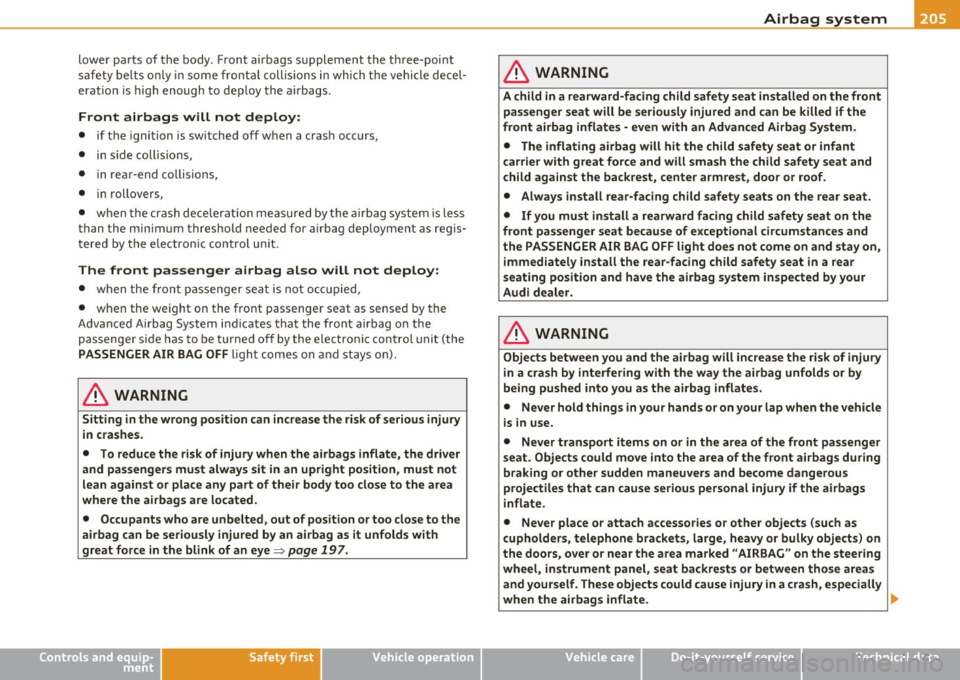
Airbag system --------------------------------------------- -=---=----
lower parts of the body . Front a irbags s upplement the t hree-poi nt
sa fety belts o nly in some fro ntal collis ions in which the vehicle decel
eration is high enough to dep loy the a irbags .
Front airbags will not deploy:
• if the ignition is switched off when a crash occurs,
• in s ide collisions ,
• in rea r-end collisions,
• in rollovers,
• when the crash decelerat io n me asured by the a irbag system is less
than the min imum threshold needed for a irbag deployment as reg is
tered by the e lectron ic con trol un it.
The front passenger airbag also will not deploy:
• when the fron t passe nger seat i s not oc cupied,
• when the weight on the front passenger seat as sensed by the
Advanced Ai rbag System in dicates that the front airbag o n the
passenger side has to be turned off by the e lectronic control unit (the
PASSENGER AIR BAG OFF li ght comes on and stays on).
& WARNING
Sitting in the wrong position can increase the ri sk of ser iou s injury
in crashes.
• To redu ce the risk of injury when the airbags inflate, the driver
and pas sengers mu st always sit in an upright position , mu st not
lean against or place any part of th eir body too close to the area
where the airbags are lo cated.
• Occupants who are unbelted, out of position or too close to the
airbag can be seriou sly injured by an airbag a s it unfolds with
great force in th e blink of an eye =>
page 197 .
Controls and equip ment Safety first Vehicle operation
& WARNING
A child in a rearward-facing child
safety se at installed on the front
pa sseng er seat will be seriously injured and can be killed if the
front airbag inflat es - ev en with an Ad van ced Airbag System .
• The inflating airbag will hit the child safety seat or infant
c arrier with great force and will smash the child safety s eat and
c hild against the backre st, center armre st, d oor or roof .
• Always install rear -facing child safet y seats on the rear seat.
• If you must install a rearward facing child safety seat on the
front passenger se at because of e xceptional circumstances and
the PASSENGER AIR BAG OFF light do es not come on and stay on ,
immediately install the rear -facing child s afety seat in a rear
s eating po sition and h ave the airbag system inspe cted by your
Audi d eal er.
& WARNING
Object s between you and the airbag will increase th e risk of inju ry
in a cra sh by int erfering with the way the airb ag unfold s or by
being pushed into you as the airbag inflates.
• Never hold things in your hand s or on your lap when the vehicle
i s in use.
• Never tran sport items on o r in the are a of the fr ont pa ssenger
seat. Obje ct s c ould move into the area of the front ai rbag s during
braking or other sudden maneu ver s and become dang erous
projectiles that can c au se se rious per sonal injury if the ai rb ags
infl ate.
• Never pla ce o r attach accessories or othe r objects (s u ch a s
cupholders, telephone brac kets, large , heavy or bulk y object s) on
the doo rs, over o r near the are a marked
"AIRBAG " on the stee ring
wheel, in strum ent panel , se at ba ckre sts or between th ose ar ea s
and yourself . These objects could cause injur y in a crash , especially
when the airbags infl ate .
9"'
Vehicle care Do-it-yourself service Technical data
Page 208 of 368

ffl..,___A_ i_rb _ a_,g,:;._ s_, y'- s_ t_e _m ________________________________________________ _
& WARNING (conti nued)
• Never recline the front passenger's seat to transport objects.
Items can also move into the area of the s ide airbag or the front
airbag during braking or in a sudden maneu ver. Objects near the
airbags can become projectiles and cause injury, particularly when
the seat is reclined .
& WARNING
The fine dust created when airbags deploy can cause breathing
problems for people with a history of asthma or other br eathing
conditions.
• To reduce the risk of breathing problems, those with asthma or
other respiratory conditions should get fresh air right
away by
getting out of the veh icle or opening windows or doors.
• If you are in a colli sion in which airbags deploy, wa sh your
hands and face with mild soap and water before eating .
• Be careful not to get the dust into your eyes, or into any cuts or
scratches.
• If the residue should get into your eyes, flush them with
water .•
Monitoring the Advanced Airbag
System
Airbag monitoring indicator light f!G
Two separate indicat ors m onit or the func tion of the
Advanc ed A irb ag Sys tem: the airbag mo nit ori ng in dic ato r
li g ht and the
PASSENGER AIR BAG OFF light.
The Advanced Airbag System (incl uding the electronic control unit,
sensor circui ts and system wiring) is mo nito red cont inuous ly to make
sure that it is f unctioning p roper ly whenever the ignition is on. Each time you t
urn on the ignit ion, the a irbag monitoring indicator light
:A
w ill come o n fo r a few secon ds (self diagnos tic s).
The system must be inspected when the indicator light ~:
• does not come on when the ignition is switched on,
• does not go out a few seconds aft er you have switc hed on the igni
tion, or
• comes on while driving.
If an airbag system malfunction is detected, the indicator light w ill
fir st start flashing to c atch t he d river's attention and then stay on
continuously to serve as a constant reminder to have the system
inspec ted immedia tely .
If a ma lfunct io n occ urs that t urns the fron t air bag on the passenger
side off, the PASSENGER AIR BAG OFF li ght will come on and stay on
w henever the igni tion is on.
& WARNING
An airbag system that is not functioning properly cannot provide
supplemental protection in a frontal crash.
• If the airbag indicator light comes on , it means that there may
be something wrong with the Advanced Airbag System . It i s
possible that the airbag will inflate when it is not supposed to, or
will not inflate when it should.
• Have the airbag system inspected immediately by your Aud i
dealer. •
Page 210 of 368
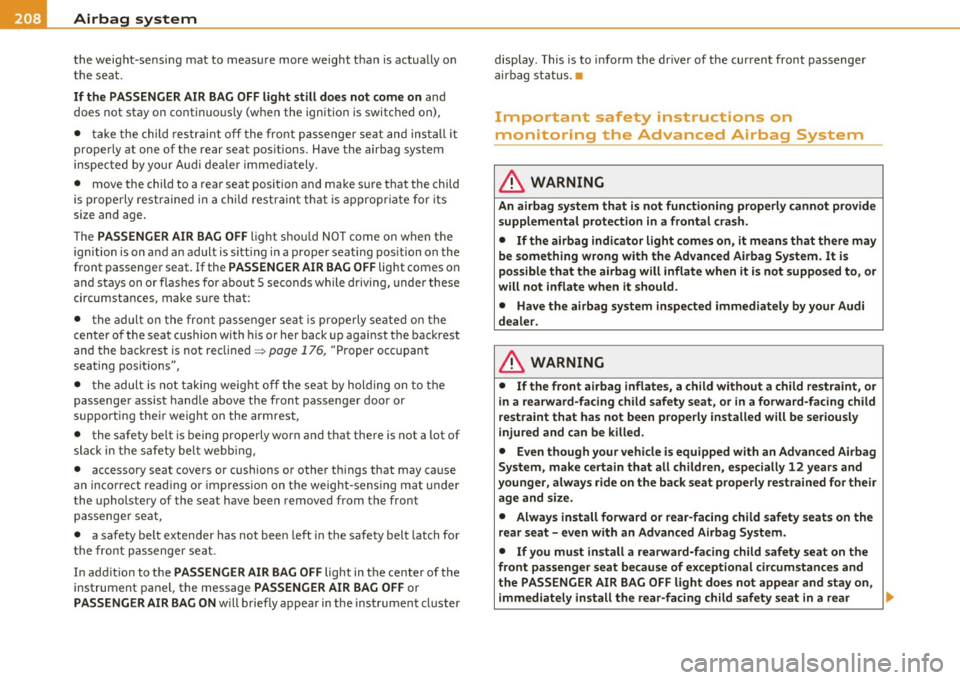
........ _A_ i_rb _ a_,g,:;._ s_, y'- s_ t_e _m ________________________________________________ _
the weight-sensing mat to measure more weight than is actua lly on
t he seat.
If the PASSENGER AIR BAG OFF light still does not come on and
does not stay on cont inuous ly (when the ignition is switched on),
• t ake the child res tra int off the fr ont p assenger seat an d ins ta ll it
properly at one of t he rear seat positions. Have the a irbag system
inspec ted by yo ur Aud i d ea le r imme diat ely.
• move the child to a rea r seat position and ma ke s ure that the child
is properly res trained in a c hild rest rain t th at i s appr opriate fo r its
size and age .
T he
PASSENGER AIR BAG OFF light shou ld NOT come on when the
ignition is on a nd an adult is sitt ing in a proper sea ting pos ition on the
front passenger seat. If the
PASSENGER AIR BAG OFF light comes on
and s tays on o r flashes fo r abo ut 5 seconds while d riving, unde r these
circumstances, make sure that:
• t he adul t on the front passenger se at is pro perly seate d on the
center of the seat cushi on with his or her back up against the backrest
an d t he bac krest is not reclined => page 176, "Proper occ upan t
seating posit ions",
• t he adult is not tak ing weig ht o ff t he sea t by holding on to th e
passenge r assist handle above the front passe nger door or
supporti ng their weight on the armrest,
• the safety belt is be ing properly wor n and that there is not a lot of
s la ck in th e s afe ty be lt webb ing,
• accessory seat cove rs or cushions o r othe r th ings that may ca use
an in co rre ct re ading o r impre ss io n on th e weigh t-sensin g m at un der
the upholstery of the seat have been removed from the front
p as senge r se at,
• a sa fety be lt extender has not been left in th e safety belt latch for
th e fr ont pas senger se at.
In addit io n to t he
PASSENGER AIR BAG OFF light in t he center of the
instrument pane l, the message
PASSENGER AIR BAG OFF o r
PASSENGER AIR BAG ON w ill briefly appea r in th e inst rument cluster display
. This is to inform the dr ive r of the current front passenger
a irb ag st atus .•
Important safety instructions on
monitoring the Advanced Airbag System
& WARNING
An airbag system that is not functioning properly cannot provide
supplemental protection in a frontal crash.
• If the airbag indicator light comes on, it means that there may
be something wrong with the Advanced Airbag System.
It is
possible that the airbag will inflate when it is not supposed to, or
will not inflate when it should.
• Have the airbag system inspected immediately by your Audi
dealer.
& WARNING
• If the front airbag inflates, a child without a child restraint , or
in a rearward-facing child safety seat, or in a forward-facing child
restraint that has not been properly installed will be seriously
injured and can be killed.
• Even though your vehicle is equipped with an Advanced Airbag
System, make certain that all children, especially 12 years and
younger, always r ide on the back seat properly restrained for their
age and size.
• Always install forward or rear-facing child safety seats on the
rear seat -even with an Advanced Airbag System.
• If you must install a rearward-facing child safety seat on the
front passenger seat because of exceptional circumstances and
the PASSENGER AIR BAG OFF light does not appear and stay on, immediately install the rear-facing child safety seat in a rear
~
Page 215 of 368
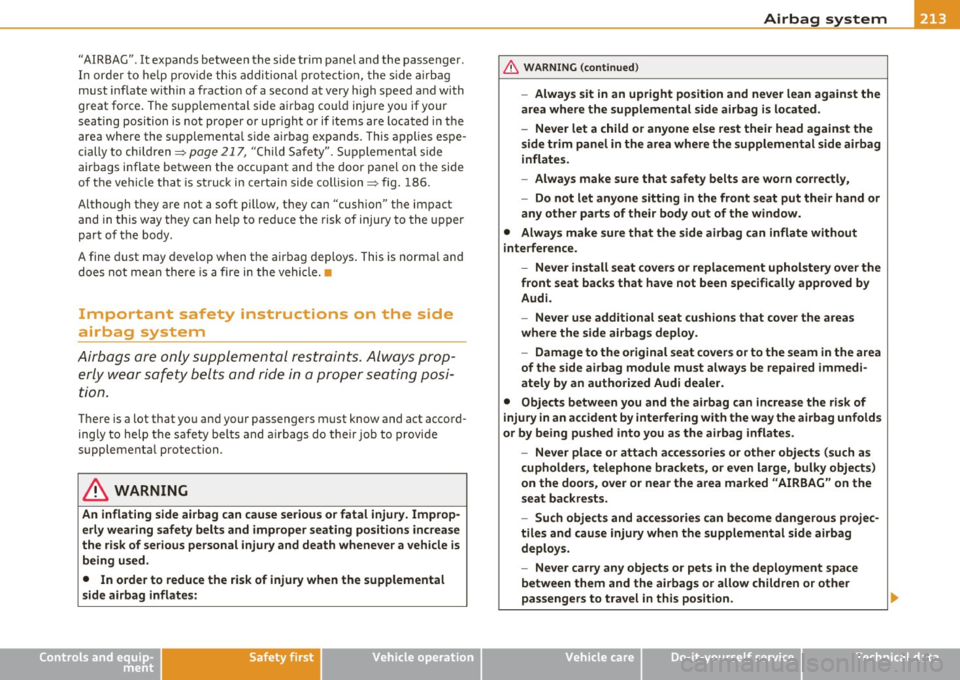
Airbag system Ill
----------------=--=---
"AIRBAG". It expands between the side tr im panel and the passenger.
I n order to he lp prov ide th is addi tion al pro te ct ion, the s ide a irbag
must inflate within a fract ion of a second at very high speed a nd with
great force . The supp lementa l sid e airbag co uld inju re you if your
seat ing position is not proper or upr ight or if items are located in the
area where the s upplementa l s ide a irbag expands . This applies espe
c ially to children=>
page 217, "Child Safety". S upplementa l side
airbags inflate between the occupant and the door panel on the side
o f the ve hicl e that is st ru ck in ce rtai n side co llision=> fig. 186 .
Although they are not a soft pillow, they can "cush ion" the impact
and in th is way they can help to reduce the risk of injury to the upper
part of the body.
A fine dust may develop when the airbag deploys. This is normal and
does not mean there is a fire in the vehicle. •
Important safety instructions on the side
airbag system
Airbags are only supplemental restrain ts. Always pr op
erly wear safe ty belts and ride in a proper seating posi
tion .
There is a lot that yo u and your passengers must know and act accord
ing ly to help the safety be lts and a irbags do the ir job to provide
supplementa l protection .
& WARNING
An inflating side ai rbag can cau se serious or fatal injury. Improp
e rl y wearing safety belts and improper seating pos itions increase
the risk of se rious pe rsonal injury a nd death whenever a vehicle is
being used .
• In order to reduce the ri sk of injury when the supplemental
s ide airbag inflates:
Controls and equip
ment Safety first Vehicle operation
& WA
RNING (continued )
-Alway s sit in an upr ight po sition and never lean again st the
area where the supplem ental side airbag is locat ed .
- Ne ver let a child or an yone el se rest their head against the
s ide trim panel in the area wh ere the supplemental side airbag
inflates.
- Alw ays make sure th at s afet y belts are worn correctly,
- Do not let anyone sitting in the front seat put their hand or
a ny other parts of their body out of the window.
• Alway s make sure that the side airbag can inflate without
interfe rence .
- N ever in stall seat covers or replac ement uphol stery over the
front seat back s that have not been specifically approved by
Audi.
- Never use additional seat cu shion s that co ve r the area s
wher e the side airbags deploy.
- Damage to the original seat co ver s or to the seam in the area
of the side airbag mod ule must a lway s be repaired immedi
ately by an authorized Audi dealer.
• Obje ct s between you and the airbag can in crea se the risk of
injur y in an accident by inte rfer ing with the wa y the airbag unfold s
or by being pushed int o you as the a irbag inflates .
- Ne ver pla ce or attach a cce sso ries or other object s (such a s
c upholders, t elephon e brack ets, or even larg e, bulky objects )
on t he d oor s, over or near the area marked "AIRBAG " on the
s e at ba ckrests .
- Su ch obje ct s and a cc es sories can be come dangerou s proj ec
tiles and cause injury when th e supplemental side airbag
deplo ys.
- Nev er ca rry any objects or pets in the d eployment space
between them and the airbag s or allow childr en or other
pas seng ers to tra vel in this position .
Vehicle care Do-it-yourself service Technical data
Page 218 of 368
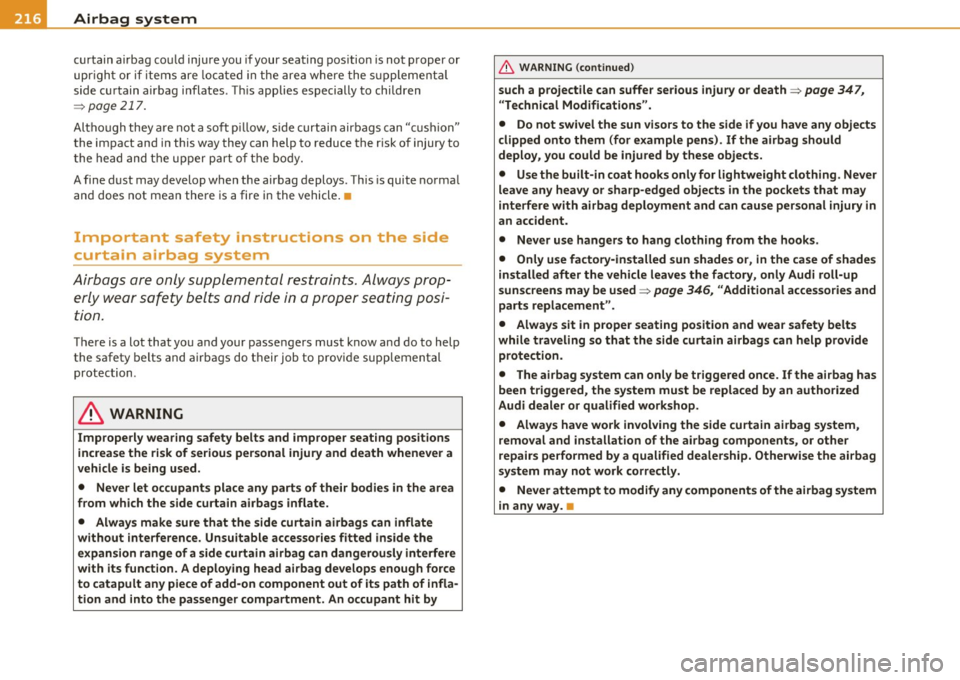
........ _A_ i_rb _ a_,g,:;._ s_, y'- s_ t_e _m ________________________________________________ _
cu rtain airbag co uld injure you if your sea ting pos ition is no t proper or
u prigh t o r if items a re locat ed in the area w here the supp leme ntal
side c urtain a irbag i nflates . T hi s applies especially to chi ldren
=> pa ge 2 17.
Al thoug h they are not a so ft pill ow, s ide cur tain air bags can " cushi on"
the im pact an d in this way they can help to reduce the risk of injury to
t he he ad an d th e upp er part of th e bod y.
A fine d ust may develop when t he airbag deploys . Th is is quite norma l
and does not mea n the re is a fire in the vehicle .•
Important safety instructions on the side
curtain airbag system
Airb ags are on ly su ppleme ntal r estraints. Always pr op
e rl y w ear s afet y belt s and rid e i n a prop er sea ting posi
tion.
T he re is a lot that yo u and your passe nge rs must know and do to help
the safety be lts and airbags do t heir job to provi de supp lemental
prot ection .
& WARNING
Improperly wearing safety belts and improper seating positions
increase the risk of serious personal injury and death whenever a
vehicle is being used .
• Never let oc cupant s place any parts of their bodies in the area
from which the side curtain airbags inflate.
• Always make sure that the side curtain airbags can inflate
without interference. Unsuitable accessories fitted inside the
expansion range of a side curtain airbag can dangerously interfere
with its function. A deploying head airbag develops enough force
to catapult any piece of add-on component out of its path of infla
tion and into the passenger compartment. An occupant hit by
& WARNING (co ntinued )
such a projectile can suffer serious injury or death=> page 347,
"Technical Modifi cations ".
• Do not swivel the sun viso rs to the side if you have any objects
clipped onto them (for example pens). If the airbag should
deploy, you could be injured by these objects.
• Use the built-in coat hooks only for lightweight clothing. Never
leave any heavy or sharp-edged objects in the pockets that may
interfere with airbag deployment and can cause personal injury in
an accident.
• Never use hangers to hang clothing from the hooks .
• Only use factory-in stalled sun shades or, in the case of shades
installed after the vehicle leaves the factory, only Audi roll-up
sunscreens may be used=>
page 346, "Additional accessories and
parts replacement ".
• Always sit in proper seating position and wear safety belts
while traveling so that the side curtain airbags can help provide
protection .
• The airbag system can only be tr iggered once. If the airbag has
been triggered, the system must be replaced by an authorized
Audi dealer or qualified workshop.
• Always have work involving the side curtain airbag system,
removal and installation of the airbag components, or other
repairs performed by a qualified dealership. Otherwise the airbag
system may not work correctly.
• Never attempt to modify any components of the airbag system
in any way. •
Page 219 of 368

___________________________________________ C_ h_il _d _ S_a _f _e _t =c,. y __ lffll
Child Safety
Important things to know
Introduction
The rear seat is generally the safest place in a collision.
Th e physical pr in ci ples o f wha t happens w hen yo ur vehicl e is in a crash
app ly a lso to children=>
page 187, "What happens to occupants not
wearing safety be lts?". But unlik e adu lts and teenagers, the ir
muscles and bones are not fully developed. In many respects c hildren
are at greate r risk of ser io us injury in cras hes than adults .
Because children 's bodies a re not f ully deve loped, they require
restraint systems especially designed fo r their size, weight, and body
st ruct ure. Many cou ntries and all states of t he Unite d States and
prov inces of Canada have laws req uiring the use of approved ch ild
restrain t sys tems for infan ts an d sm all ch ild ren .
I n a fronta l crash at a speed of 20 -35 mph (30-56 km/h) the forces
act ing o n a 13- pound (6 kg) infant w ill be more than 20 times the
we ight of the ch ild . This means the we ight of the child wo uld
suddenly be more than 260 po unds (120 kg). Unde r these conditions,
only a n app ropr iat e child restra int proper ly used can red uce the risk
of serious injury. Child restraints, like adult sa fety be lts, must be used
pro perl y to be effective. Use d imprope rly, they can i ncrease t he ris k
of serious injury in an accident.
C onsult the ch ild safety seat manufacturer's instr uctions in order to
be sure the seat is r ight for you r child's size=>
page 220, "Important
safety instructions fo r using child safety seats". P lease be s ure to
read and heed a ll of the important informa tion and WAR NINGS
about chi ld safety, Advanced Airbags, an d the installation of child
restra in ts in this chapte r.
There is a lot you need to know about the Advanced Airbags in your
vehicle and how t hey wo rk when inf ants and childre n in child
restra ints are on the front passenger seat. Beca use of t he large
Controls and equip
ment Safety first Vehicle operation
amou
nt of importa nt info rmation, we cannot repeat i t all he re. We
urge you to read the detailed information in th is owne r's man ua l
abou t airbags and t he Advanced A irbag Syste m in your vehicle and the
very important information abo ut transporting c hildren on the front
p assenger se at. P lea se be sure to heed the WARNIN GS - they a re
extremely important for your safety and the safety of your passe n
gers, especially infan ts and small ch il dre n.
& WARNING
• Accid ent statisti cs have shown that children are generally safer
in the rear seat area than in the front seating position. Always
re strain any child age 12 and under in the rear.
• All vehicle occupants and especially children must be
restrained properly when ever riding in a vehicle. An unre strained
or improperly restrained child could be injured by striking the
interior or by being ejected from the vehicle during a sudden
maneuver or impact. An unrestrained or improperly rest rained
child is also at greater risk of injury or death through contact with
an inflat ing airbag .
• A suitable child restraint properly installed and used at one of
the rear seating pos itions provides the highest degree of protec
tion for infants and small children in most accident situations.
& WARNING
Children on the front seat of any car even with Advanced Airbags
can be seriously injured or even killed when an airbag inflates. A
c hild in a rearward -facing child safety seat in stalled on the front
passenger seat will be seriously injured and can be killed if the
front airbag inflate s.
• The inflating airbag will hit the child safety seat or infant
c arrier with great force and will sma sh the child safety seat and
child aga inst the backrest, center armrest , or door . •
Vehicle care Do-it-yourself service Technical data
Page 220 of 368
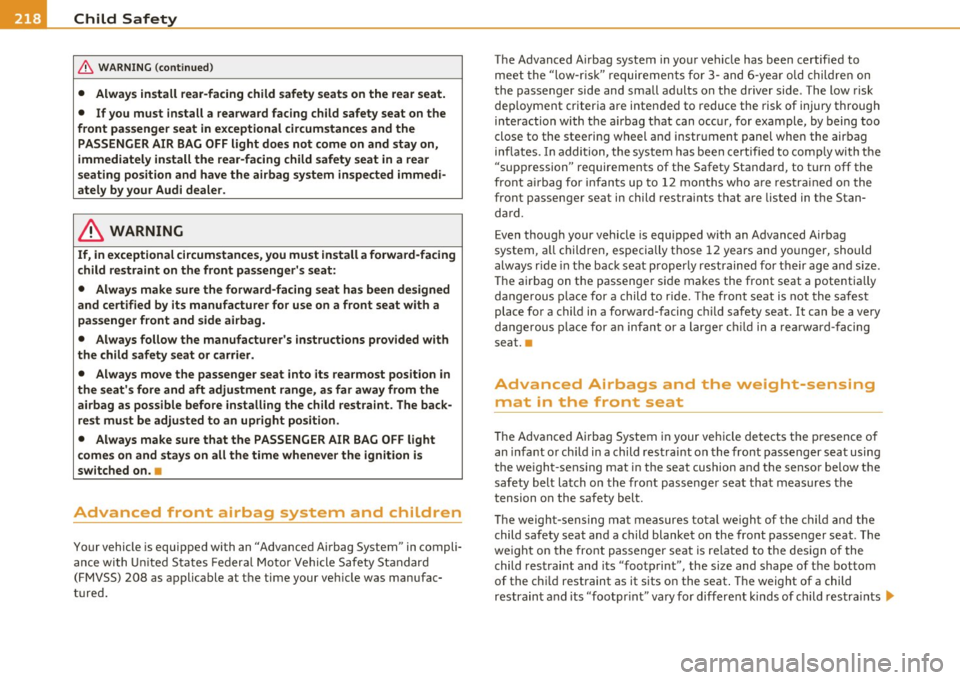
-Child Safety ------ ~---------------------------------
& WA RNING (conti nued)
• Always install rear-facing child safet y seat s on the rear seat.
• If you must install a rearward facing child safety seat on the
front passenger seat in exceptional circumstances and the
PASSENGER AIR BAG OFF light do es not come on and stay on,
immediately in stall the rear-facing child safety seat in a rea r
seating position and have the airbag system inspected immedi
ately by you r Audi deale r.
& WARNING
If, in exceptional circumstances , you must in stall a forward-facing
child restraint on the front passenger' s seat:
• Always make sure the forward-facing seat has been designed
and certified by its manufacturer for use on a front seat with a
pa ssenger front and side airbag.
• Always follow the manufacturer 's instructions p rovided with
the child safety seat or carrier.
• Always move the passenger seat into its rearmost position in
the seat's fore and aft adjustment range, as far away from the
airbag as possible before install ing the child restra int . The back
re st must be adju sted to an upright position .
• Always make sure that the PASSENGER AIR BAG OFF light
c omes on and stays on all the time whenever the ignition i s
switched on .•
Advanced front airbag system and children
Your vehicle is equipped with an "Advanced Airbag System" in compli
ance wi th Uni ted St ates Federa l Mo to r Vehicle Safety St andar d
(FMVSS) 208 as applicable at the time your veh icle was manufac
tu red . The Advanced A
irbag system in yo ur vehicle has been certif ied to
mee t the "low -r is k" requiremen ts fo r 3-and 6-ye ar old ch ildre n on
t he passenger side and small adults on the dr iver side . The low risk
dep loyment criteria are inten ded to reduce the risk of injury through
interaction with the a irbag t hat can occur, for example, by being too
close to the stee ring wheel an d instr ument panel when the airbag
inflates. In addi tion, the sy stem has been certified to comp ly with t he
"suppression" requirements of the Safety Standa rd, to t urn off the
fron t air bag for infan ts u p to 1 2 months who a re res tra ined on the
front passenger seat in child restrai nts that are listed in the Stan
d ar d.
Even thoug h your vehicle is equipped with an Advanced Airbag
system , a ll ch ildren, especially those 12 years and yo unger, should
always r ide in t he back seat p roperly restrained for t heir ag e and si ze .
Th e ai rbag on the passenge r si de makes the front seat a potentia lly
dange rous p lace for a child to r ide. Th e front seat is not th e safest
place fo r a child in a forward- facing c hild safety seat. It can be a very
d an ge rous p lace for a n infan t or a large r chil d i n a re arwa rd-facing
seat. •
Advanced Airbags and the weight-sensing
mat in the front seat
Th e Advanced A irbag System i n your ve hicle de tects t he p resence o f
an infa nt o r ch ild in a child rest rai nt on the fro nt passenger sea t using
the we ight-sens ing mat in the seat cushion and the senso r be low the
saf ety belt la tch o n th e front passenge r seat tha t measur es t he
tension on the safety belt.
Th e weigh t-sens ing ma t me asures tot al we ight of the child and the
child safety seat and a child blanket on the fro nt passe nger seat . The
we ight on the fro nt passenger se at is re late d t o the desi gn of the
child res traint and i ts "footpri nt", the size and shape of t he bottom
of the ch ild restraint as it sits o n the seat . The weight of a child
restrain t an d its "foo tpr int" vary for differe nt kinds of child res tra ints .,_
Page 222 of 368
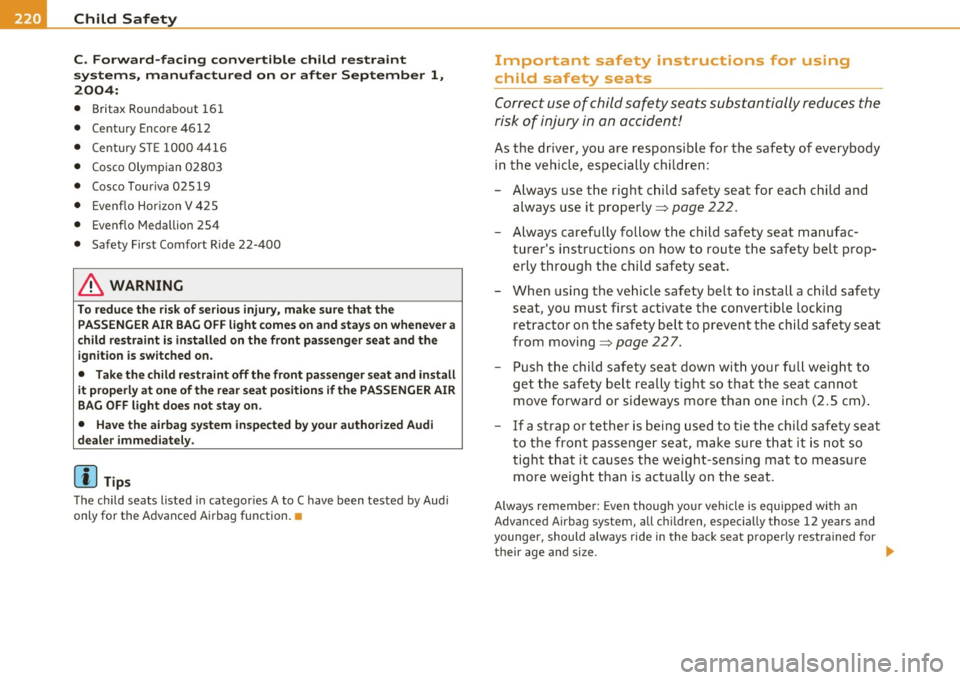
_,___C_ h_ il_d _ S_a _ f_ e _ t-= y ;....._ ____________________________________________ _
C. Forward-facing convertible child restraint
systems, manufactured on or after September 1,
2004:
• Britax Roundabout 161
• Century Encore 4612
• Century STE 1000 4416
• Cosco Olympian 02803
• Cosco Touriva 02519
• Evenflo Horizon V 425
• Evenflo Medallion 254
• Safety First Comfort Ride 22-400
& WARNING
To reduce the risk of serious injury, make sure that the
PASSENGER AIR BAG OFF light comes on and stays on whenever a
child restraint is installed on the front passenger seat and the ignition is switched on.
• Take the child restraint off the front passenger seat and install
it properly at one of the rear seat positions if the PASSENGER AIR BAG OFF light does not stay on.
• Have the airbag system inspected by your authorized Audi
dealer immediately.
W Tips
The child seats listed in categories A to C have been tested by Audi
only for the Advanced Airbag function. •
Important safety instructions for using
child safety seats
Correct use of child safety seats substantially reduces the
risk of injury in an accident!
As the driver, you are responsible for the safety of everybody
in the vehicle, especially children:
Always use the right child safety seat for each child and
always use it properly~
page 222.
-Always carefully follow the child safety seat manufac
turer's instructions on how to route the safety belt prop
erly through the child safety seat.
- When using the vehicle safety belt to install a child safety
seat, you must first activate the convertible locking retractor on the safety belt to prevent the child safety seat
from moving ~
page 227.
-Push the child safety seat down with your full weight to
get the safety belt really tight so that the seat cannot
move forward or sideways more than one inch (2.5 cm).
- If a strap or tether is being used to tie the child safety seat
to the front passenger seat, make sure that it is not so
tight that it causes the weight-sensing mat to measure more weight than is actually on the seat.
Always remember: Even though your vehicle is equipped with an
Advanced Airbag system, all children, especially those 12 years and
younger, should always ride in the back seat properly restrained for
their age and size . _,,